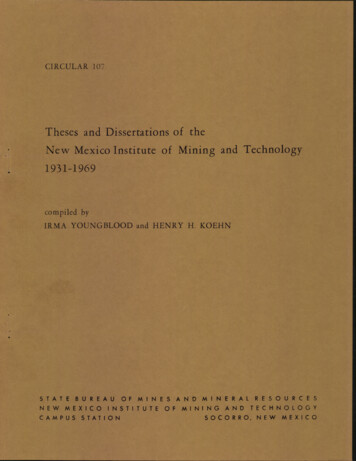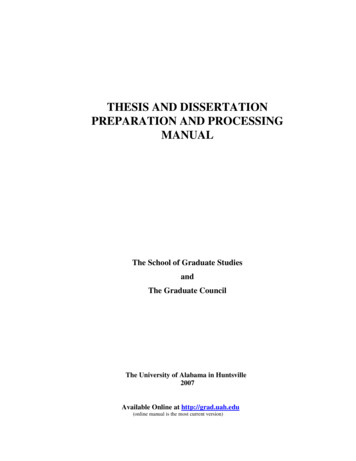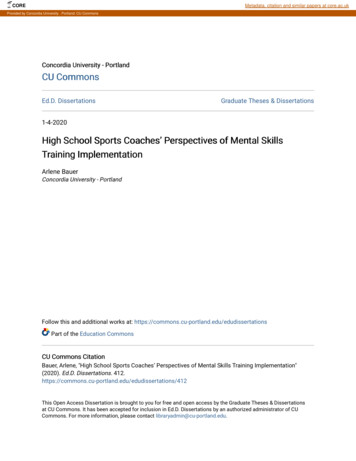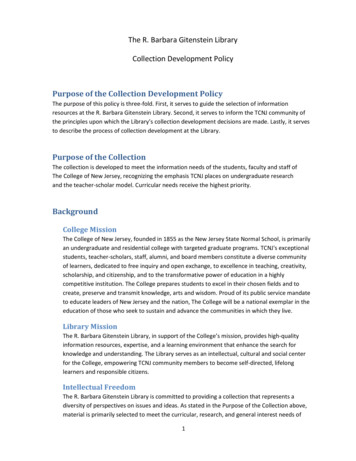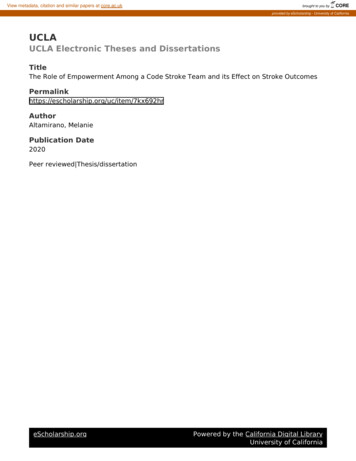
Transcription
View metadata, citation and similar papers at core.ac.ukbrought to you byCOREprovided by eScholarship - University of CaliforniaUCLAUCLA Electronic Theses and DissertationsTitleThe Role of Empowerment Among a Code Stroke Team and its Effect on Stroke 7kx692hrAuthorAltamirano, MelaniePublication Date2020Peer reviewed Thesis/dissertationeScholarship.orgPowered by the California Digital LibraryUniversity of California
UNIVERSITY OF CALIFORNIALos AngelesThe Role of Empowerment Among a Code Stroke Team and its Effect on Stroke OutcomesA dissertation submitted in partial satisfaction of therequirements for the degree Doctor of Nursing PracticebyMelanie Altamirano2020
Copyright byMelanie Altamirano2020
ABSTRACT OF THE DISSERTATIONThe Role of Empowerment Among a Code Stroke Team and its Effect on Stroke OutcomesbyMelanie AltamiranoDoctor of Nursing PracticeUniversity of California, Los Angeles, 2020Professor Wendie A. Robbins, ChairBackground: Code Stroke Teams in hospitals provide emergency deployment of stroke clinicalcare experts for treatment of an acute stroke. Code Stroke Teams monitor their effectivenessusing standards for stroke patient outcomes provided by the American Heart Association (AHA)and American Stroke Association (ASA) Stroke measures. This project was conducted in aSouthern California suburban hospital where changes in leadership and high turnover rates hadled to Code Stroke Team members experiencing decreased motivation, job satisfaction and lowmorale leading to substandard stroke patient outcomes.Aim: This quality improvement project aimed to empower staff, improve performance andstroke outcomes by giving monthly presentations of successful Code Stroke cases to the StrokePerformance Improvement Committee leaders and stroke team staff.Methods: Stroke Performance Improvement Committee leaders and stroke team staffparticipated monthly in an empowerment intervention through presentation of a stroke case on a“Code Stroke Spotlight” handout (Educational Empowerment Tool) over a 3 month period.Using a repeated measures, pre- post design, staff empowerment (measured by the PsychologicalEmpowerment Instrument) and American Heart Association (AHA) Core Emergencyii
Department Stroke Measures were collected prior to the intervention at baseline and postempowerment intervention following monthly implementation over 3 months.Results: Results showed statistically significant improvement in all items on the PsychologicalEmpowerment (PE) Instrument using Wilcoxon signed-rank test (p 0.05) (N 32). Door toneuro MD (neurologic expertise consult) 15 minutes showed significant improvement postintervention (z -2.285, p 0.023). Door to PT/INR result 45 minutes showed statisticalsignificance (z -2.931, p 0.003). Door to CT film 20 minutes showed no change (z 0.000, p 1.000). For the remaining goals there was improvement in right direction, demonstratingdecreased door to activation times, though these did not reach statistical significance.Discussion: Implementation of the ‘Code Stroke Empowerment Spotlight’ interventioneffectively improved staff empowerment and performance on American Heart Association(AHA) and American Stroke Association (ASA) Stroke core measures. Future studies areneeded to evaluate positive reinforcement, meaningful recognition, and empowerment specific tothose caring for stroke patients.iii
The dissertation of Melanie Altamirano is approved.Joann O. EastwoodMary Ann ShinnickYeonsu SongWendie A. Robbins, Committee ChairUniversity of California, Los Angeles2020iv
DedicationThis work is dedicated to my father, Rolando Altamirano, who suffered a stroke in 2004 andsince has been my motivation for nursing excellence and improvement in stroke care.v
Table of ContentsChapter one: Introduction. . .1Problem Statement. .1PICOT Question . .2Purpose and Objectives 2Chapter Two: Theoretical Framework . 4Chapter Three: Synthesis of Evidence .6Evidence Search .6Synthesis 10Chapter Four: Methods . .12Interventions . .12Data Collection .13Data Collection Instruments .13Demographic Questionnaire .14Psychological Empowerment Instrument .14AHA Core Emergency Department Stroke Measures .15Analysis .15Chapter Five: Results . .17Demographic Questionnaire .17Psychological Empowerment Instrument .17AHA Core Emergency Department Stroke Measures .18Chapter Six: Discussion .24Limitations. 25Implications for Practice 26Chapter Seven: Conclusion . .28Appendices .29Appendix A Stroke Performance Improvement Leaders .29Appendix B “Code Stroke Empowerment Spotlight” Handout Example .30Appendix C AHA Core Emergency Department Stroke Measures .31Appendix D DNP Scholarly Project Flow Chart .32Appendix E Demographic Questionnaire .33Appendix F Psychological Empowerment Survey 34Appendix G Table of Evidence . . .35References . .43vi
List of Tables and FiguresTables and FiguresTable 1 Demographic Questionnaire Results .20Table 2 Psychological Empowerment Instrument Wilcoxon Signed Rank Test Results.21Figure 1 AHA Core Emergency Department Stroke Measures Data .22Table 3 Stroke Core Measures Two-sample Wilcoxon Rank-Sum Test Result . .23vii
AcknowledgementsFirst and foremost, I would like to Thank God, above all, none of this would be possible.I would like to personally thank my Committee Chair, Dr. Wendie Robbins,I have been so blessed to have you as my chair. Thank you for guiding me throughout this entireDNP program. Thank you for the assistance in preparation of my project, oral defense,implementation of my project, results, analysis and written dissertation. Thanks for stayingpositive and reassuring me whenever I needed it. Thank you for all your time and effort spent onallowing this project to be successful. I am really thankful to have you as my chair. I would notbe here today without you.To my committee, Dr. Mary Ann Shinnick, Dr. Jo-Ann Eastwood and Dr. Yeonsu Song,Thank you so much for all you have done for me. Thank you for preparing me for my oraldefense, written proposal and final dissertation. I really appreciate and respect all your feedback,suggestions and words of wisdom. This dissertation and completion of this program would nothave been possible without an amazing committee like you!To Dr. Nancy Jo Bush,Thank you so much for everything you have done for me and our class! This was an amazingjourney and we owe it all to you! I am thankful to have been in this DNP program with you asour Director, Professor and mentor. You have been so loving, supportive, and have been anamazing role model for all of us. Thanks for all that you have done for us. This dissertation andsuccess of this DNP project is also your success! I cannot thank you enough!To my family, Rolando Altamirano (Dad), Ophelia Altamirano (Mom), Mark Altamirano(Brother), and Michelle Altamirano Bautista (Sister),Thank you for being the most amazing, loving and supportive family I could ever ask for.Thanks for being my motivation and providing me with the support and love needed to make itall the way to this point. My success is your success!Lastly, to my Fiancé Winston Cariaga, Thank you for supporting me, loving me, and pushing meto be a better person every single day. I am so blessed to have you and can’t imagine my lifewithout you. This DNP program and dissertation would not be possible without all your love andsupport. Every day I thank God for blessing me with such an amazing man to spend my lifewith! I love you and can’t wait to marry you!viii
Biographical SketchMelanie Altamirano, MSN, RN, AGACNP-BCEducation2018 – 2020, University of California, Los Angeles Degree in Progress: Doctor of Nursing Practice2012 – 2014, California State University, Los Angeles Master of Science in Nursing, Adult-Gerontology Acute Care Nurse Practitioner2008 – 2011, California State University, Los Angeles Bachelor of Science in Nursing2005 – 2008, California State University, Long Beach Bachelor of Science in Health Care AdministrationWork ExperienceMarch. 2020 – Present, Los Alamitos Medical Center, Los Alamitos, CANeuroscience Nurse PractitionerFeb. 2018 – Present, St. Francis Medical Center, Lynwood, CAClinical Stroke Nurse PractitionerMay. 2017 - Present, Neurologist Dr. Amir Zangiabadi, Lynwood, CANeurology Nurse PractitionerDec. 2016 – Feb. 2018, County of Los Angeles, Harbor-UCLA Med. Center, Torrance, CATrauma/Acute Care Surgery/Surgical Intensive Care Unit Nurse PractitionerDec. 2015 - Jan. 2017, St. Francis Medical Center, Lynwood, CAStroke Program Coordinator Nurse PractitionerNeurology Nurse PractitionerNov. 2014 – Nov. 2015, Prime Neurology, Inc., Sherman Oaks, CANeurology Nurse PractitionerAug. 2011 – Nov. 2014, Providence Little Company of Mary Med. Center, San Pedro, CARegistered Nurse – Telemetry/Critical CareAdjunct Faculty Educator and Simulation Trainer – Education DepartmentAwards and Honors2020, UCLA DNP School of Nursing Scholarship, UCLA.2019, St. Francis Medical Center Medical Staff Scholarship Recipient, SFMC.2019, UCLA DNP School of Nursing Scholarship, UCLA.2019, Paula Anastacia DNP Scholarship, UCLA.2013, Centofante Nursing Education Endowment Fund, Providence LCOM.2011, Anna Bing Arnold Scholarship, CSULA.2011, Sigma Theta Tau International, Honor Society of Nursing, CSULA.2011, Golden Key International Honor Society, CSULA.2008, Who's Who Among Students in American Universities and Colleges, CSULB.2006, CSU Scholarship Program for Future Scholars Award, CSULB.Presentations2020 UCLA Virtual Research Day: The Role of Empowerment Among a Code Stroke Team andits Effect on Stroke Outcomes.ix
CHAPTER ONEIntroductionIn the United States, 795,000 people have a stroke each year (CDC, 2020). Stroke is thefifth leading cause of death and the leading cause of disability in the United States (CDC, 2020).At the Southern California suburban hospital where this Doctor of Nurse Practice (DNP)scholarly project was conducted, an estimated 500 patients present for stroke symptoms per year.Successful code stroke (emergency deployment of an expert stroke team for treatment of anacute stroke patient) cases at this hospital are defined as examples in which Tissue PlasminogenActivator (TPA) or Alteplase is administered within 60 minutes of a patient’s arrival time. TPAis the current gold standard for stroke treatment to dissolve a clot and improve blood flow in thebrain improving outcomes when administered in the hyper-acute time frame, less than 3-4.5hours after onset of stroke (Demaerschalk et al., 2016). Stroke Core time frames for TPA aredesignated by the American Heart Association (AHA) and measured by stroke designatedhospitals, which also include specific quality measures necessary prior to rapid administration ofTPA. At the site for the DNP scholarly project, these quality measures are known as the AHACore Emergency Department Stroke Measures (Appendix C).Problem StatementIn a Southern California suburban hospital, changes in leadership and high staff turnoverrates have led to Code Stroke Team members experiencing decreased motivation, decreased jobsatisfaction and low morale, ultimately leading to poor stroke patient outcomes. Staff havestated they are constantly receiving negative feedback regarding poor performance, creating aperceived culture of blame. Current feedback to one Code Stroke Team regarding stroke carehas been focused on poor performance and low scores on the AHA recommended Target Stroke1
(AHA, 2019) and facility specific measures (the AHA Core Emergency Department StrokeMeasures, Appendix C). The need for positive reinforcement, acknowledgement, empowerment,and consistent and timely Code Stroke Team feedback is highly desired by the stroke team toimprove performance.PICOT QUESTIONThe following PICO(T) question was developed: Would frontline staff empowermentthrough monthly dissemination of Code Stroke successes improve Code Stroke Teamperformance within three months at a suburban medical center in SouthernCalifornia? Interventions included presentations of one successful Code Stroke case per month,over a course of a three month period. Data was disseminated to the appropriate strokeperformance improvement team and their staff to provide positive feedback and acknowledgeoutstanding performance.Purpose and ObjectivesThis DNP Scholarly Project aimed to test the effects of an empowerment intervention onleaders and staff. The intervention consisted of positive feedback through monthly presentationsof successful Code Stroke cases by the Principal Investigator to the Stroke PerformanceImprovement Committee leaders (Appendix A) and stroke team department staff using “CodeStroke Empowerment Spotlight” handouts (Appendix B).Empowerment of leaders and staff may increase staff motivation, enhancemeaningfulness, and encourage decision making. Empowerment has been shown to lead to achange in institutional culture and patient safety, promoting the highest quality of care (Asiri etal., 2016). Research has demonstrated the benefits of empowerment: teamwork, increasedknowledge, increased use of current evidence-based practice, increased patient safety and quality2
care (Tinkham, 2013). Additionally, empowered working environments have been associatedwith positive attitudes, job satisfaction, and effective performance (de Almeida, OrgambídezRamos, & Batista, 2017).3
CHAPTER TWOTheoretical FrameworkThe theoretical framework used for this project was the Relationship-Based Care (RBC)Model. The RBC Model provides the philosophical foundation and operational framework forthe organizational transformation of care and services by focusing on relationships, team vision,and anticipated outcomes (Koloroutis, 2004). Effective relationships and teamwork are focusedon the mission and values of the patient and their families, providers, and staff from alldisciplines. The model recognizes each team member’s contribution and impact on nursing careand patient satisfaction. Positive outcomes promoted by the model in clinical areas includesafety, quality, patient and staff satisfaction, recruitment and retention, and finances (Koloroutis,2004).Six essential components of the model include leadership, teamwork, nursing practice,patient care delivery, resource driven practice, and outcomes measurement (Koloroutis, 2004).Of these components, leadership refers to leaders creating a caring and healing culture,decentralizing decision making, and eliminating barriers to quality of care. Teamwork refers tointerdisciplinary collaboration through healthy relationships for high quality patient care.Nursing practice involves competent clinical practice to achieve clinical knowledge, proficiencyand compassionate care. Patient care delivery refers to support of the professional role,promotion of collegiate relationships, organization and utilization of resources. Resource drivenpractice refers to maximizing all resources including staff time, equipment, and budget, toachieve safe care. Lastly, outcomes measurement refers to measuring outcomes to raisestandards, increase positive outcomes, and use of a visual meaningful representation of outcomesfor the team to see (Koloroutis, 2004).4
Application of the RBC Model has the potential to create positive relationships andprovide a culture of learning and shared leadership. A shift in organizational principles canoccur by communicating relevant information among team members. This process isfundamental to empowering people in decision making and taking responsibility for results. TheRBC Model led to improved patient satisfaction, decreased falls, and led to improved staffefficiency (Woolley et al., 2012). Further research found that the model empowers nurses to getto know the patient in order to provide the best care, while also recognizing their value to theorganization (Allen & Vitale-Nolen, 2005). An additional study reported findings that supportthe model improves nurse-to-patient relationships, increases job satisfaction, decreases turnover,and promotes positive patient outcomes (Carabetta, Lombardo, & Kline, 2013).5
CHAPTER THREESynthesis of EvidenceEvidence SearchThe literature search focused on stroke, teams, empowerment and patient outcomes.Pubmed, Cumulative Index to Nursing and Allied Health Literature (CINAHL), Cochrane andEmbase were searched. Three hundred articles regarding keywords including teamempowerment, Code Stroke Teams, interdisciplinary teams, and patient outcomes were found.Boolean search was carried out which also included use of the following combination of terms:team and empowerment, stroke team and empowerment, empowerment and interventions,interdisciplinary team and empowerment, stroke and interdisciplinary team, empowerment andpatient outcomes, stroke and outcomes. Quantitative and qualitative research was searched.Articles were chosen based on the purpose of the article, size of sample, methods and mostrelevant results. More refined searches included academic journals, full text articles, researchwithin the last five years, and printed in English. Specific articles that were chosen showedevidence of empowerment and its effects on patient outcomes, roles of empowerment and itseffect on job satisfaction, leadership styles and empowerment, healthy work environments, anduse of workplace empowerment strategies to disseminate knowledge. Although the focus of thissearch was intended to find evidence of an empowerment intervention targeting stroke care inemergency departments among stroke teams, none were found. Five articles were chosen for theDNP scholarly project which discussed evidence of empowerment, patient outcomes, jobsatisfaction, and use of workplace empowerment strategies to disseminate knowledge (SeeAppendix G, Table of Evidence).6
A survey study by Breau and Rheaume (2014) investigated empowerment and theworkplace to delineate if the work environment had an effect on job satisfaction, intent to leave,and quality of care among nurses (N 533). The study used three validated tools to measurehealthy work environments, job satisfaction, and patient outcomes. The Practice EnvironmentScale of Nursing Work Index (PES-NWI), a 31- item instrument measuring work environment,showed Cronbach’s alpha coefficients ranging from 0.80-0.88. Based on the PES-NWI, ICUaccess to opportunity was the most empowering (M 3.57, SD 0.73), while support (M 2.44,SD 0.86) and formal power (M 2.60, SD 0.88), were the least empowering. TheConditions of Work Effectiveness Questionnaire-II (CWEQ-II), measuring nursing perceptionsof empowerment through a 19-item Likert scale, showed internal consistency (Cronbach’s alpha)ranging from 0.80 to 0.90. Job satisfaction was measured by the Minnesota SatisfactionQuestionnaire (MSQ), a 20- item scale, with internal consistency and reliability ranging from0.80 to 0.84. Variables were predicted with hierarchical regression analysis. Regressionanalysis indicated empowerment subscales predicted 63.4% variance of work environment,demonstrating workplace empowerment predicted a positive work environment. The regressionindicated that dimensions of empowerment (access, resources and formal power) and of workenvironment (performance, leadership and support) predicted 68.9% of job satisfaction. Thisshowed access to empowerment and leadership led to greater job satisfaction. The thirdregression analysis predicted access, support and empowerment predicted 16.6% intent to leave.The fourth regression demonstrated empowerment predicted only 20.8% of perceived quality ofcare. Correlation analysis demonstrated a significant correlation between empowerment and thework environment (r 0.79), a strong correlation between access to information (empowerment)and nurses participation in workplace affairs (work environment) (r 0.65), a strong correlation7
between support and work environment in regards to performance, leadership, and support fromnurse manager (r 0.57), and a strong correlation between empowerment and perceived qualitycare (r 0.52). These results indicated that the nurses in this sample were empowered, ratingtheir work as a positive environment and perceiving their work as quality care.Another study evaluated an effect of structural empowerment and its effect on jobsatisfaction (de Almeida, Orgambídez-Ramos, & Batista, 2017). One hundred and fifty-onenurses participated in a survey using two validated questionnaries: The CWEQ-II and the JobSatisfaction Scale. The CWEQ-II demonstrated high reliability (Cronbach’s alpha 0.93, 0.77,0.72, and 0.92). The Job Satisfaction Scale had a Cronbach’s alpha of 0.81. Results of the studydemonstrated that structural empowerment and global empowerment were positively related tojob satisfaction (p 0.001), and correlated to access to opportunities referring to growth andpromotion (r 0.55), access to information referring to technological knowledge and expertiserequired (r 0.41), access to resources referring to capacity to acquire resources(r 0.37) andglobal empowerment referring to sense of access to resources, information, and autonomy (r 0.52).A study by Asiri et al. (2016) evaluated the effects of specific leadership styles onempowerment and its effect on nurse commitment. This study had a 95% return rate of 332 outof 350 self-reported questionnaires. Three validated survey instruments were used: (1)Multifactorial Leadership Questionnaire (MLQ) evaluating leadership styles, (2) PsychologicalEmpowerment scale (PE) evaluating level of empowerment, and (3) Three-Component Model ofEmployee Commitment measuring levels of organizational commitment. Reliability of the threeinstruments were high (Cronbach’s alpha of 0.94, 0.94 and 0.79 respectively). Results of this8
study showed psychological empowerment and autonomy were positively correlated withorganizational commitment (p 0.016).Empowerment has also been studied in relation to evidenced based practice (Belden,Leafman, Nehrenz, & Miller, 2012). Out of 500 potential participants, 42 nurses responded tothe survey, which demonsrated a low rate of return, causing a threat to interval validity. TheEvidence-Based Practice Questionnaire used a 24 item survey, which showed Cronbach’s alphaof 0.70 to 0.87, with construct validity (correlation coefficients ranging from 0.3 - 0.4) (p 0.001). The PE instrument was used, consisting of a 12-item self-perceptions survey;Cronbach’s alpha of 0.72 and validity of 0.80. Results showed that evidence based practice ispositively correlated to workplace empowerment (r 0.656, p 0.000). Results alsodemonstrated strong positive correlation between utilization of evidenced based practice andworkplace empowerment (r 0.648, p 0.01).Singh et al. (2015) tested evidence based practice through a knowledge transfer team(KTT) approach among nurses. The KTT is described as transferring knowledge about bestpractice guidelines to staff, through mobilization of information by champions. This studydescribes knowledge transfer as a process incorporating cognitive and interprofessional factorsaffecting shared knowledge. The KTT staff attended educational sessions to learn the process ofknowledge transfer and the best practice guideline of the Canadian Neurological Stroke Scale(CNSS). Use of the Knowledge and Self-Efficacy Survey were completed by the KTT staff atpoint of care and after implementation of the best practice guidelines, although reliability andvalidity were not stated. Findings showed that the staff felt the KTT approach was an effectivemethod of implementation and dissemination of stroke practice guidelines. A self-efficacysurvey was administered to evaluate whether an individual’s belief in a specific behavior can9
lead to an improved outcome. In this study, both pre implementation and post implementationself-efficacy had a mean score of 2.9 (SD 0.77), indicating a moderate level of self-efficacy.This suggests that the stronger the self-efficacy, the more likely a person will place effort intoaccomplishing the goal.SynthesisFor this DNP scholarly project, studies were chosen showing evidence of empowerment,patient outcomes, job satisfaction, and use of workplace empowerment strategies to disseminateknowledge. Studies in the literature have shown evidence of empowerment with improvedpatient outcomes and increased job satisfaction by implementing workplace empowermentstrategies to disseminate knowledge (Breau & Rheaume, 2014; de Almeida, Orgambídez-Ramos,& Batista 2017; Asiri et al., 2016; Belden et al., 2012). These studies included qualitativedesigns with the use of validated pre-and- post test instruments. Further, the relationships ofempowerment and leadership styles, quality of care, nursing commitment, and evidenced basedpractice were assessed. Positive correlations have also been demonstrated betweenempowerment, and leadership support, access to resources, opportunities for growth, improvedperformance, and organizational commitment. Based on these studies, increased empowermentwas highly correlated with improved performance and commitment to the organization. Singh etal. (2015) assessed implementation of evidence based practice through an education andknowledge transfer approach in order to educate and empower staff resulting in an overallimprovement in patient outcomes. Although these studies were beneficial in evaluatingempowerment, similar limitations including small sample sizes, and specific population orgeographic locations, affected the generalizability of the studies on a larger scale. Future studies10
are needed to further evaluate positive reinforcement, meaningful recognition, and empowermentspecific to those caring for stroke patients.11
CHAPTER FOURMethodsThe DNP Scholarly Project applied a pre- post design in a hospital setting to investigatethe effects of an empowerment intervention on staff performance in Code Stroke efficiency.This project was preapproved by the institution and was designated exempt from review by theHospital and University’s Institutional Review Board. AHA Core Emergency DepartmentStroke Measures (Appendix C) were evaluated pre and post implementation of the “Code StrokeEmpowerment Spotlight” intervention. Stroke team leaders were recruited from those attendingstroke performance evaluation meetings. Staff were recruited at meetings specifically held totalk about the project and invite participation. Staff were also recruited during unit huddles.Over the course of three months, three Code Stroke cases were highlighted per month during thestroke performance improvement meetings. A Psychological Empowerment instrument bySpreitzer (Belden et al., 2012), was approved for use and was administered to the stroke teamleaders and staff prior to the intervention (pre-intervention) and again following the third monthof the intervention (post-intervention).InterventionsAn empowerment intervention through positive reinforcement of interdisciplinary CodeStroke Team leaders included a presentation of data and discussion of a successful Code Strokecase through distribution of “Code Stroke Spotlights” handouts (Educational EmpowermentTool) by the Principal Investigator (PI) of this DNP scholarly project. Appreciation for the teamwas verbalized during the stroke performance improvement meeting prior to distribution of the“Code Stroke Spotlights.” These handouts were then disseminated by the stroke team leaders totheir staff. Supplemental reinforcement of the intervention through the “Code Stroke Spotlights”12
handouts were administered to staff at monthly staff meetings and unit huddles. The interventionaimed to empower and reestablish common goals and improve teamwork through sharingpositive data regarding a prior successful TPA case and the patient’s improved neurologicoutcomes.A TPA patient with improved outcomes was presented to Code Stroke Team staff on aneducational handout, known as the “Code Stroke Spotlight” (Appendix B). The educationalempowerment tool highlighted a detailed case review of the following: De-identified strokepatient’s history of present illness, chief complaint on admission, stroke symptoms, last knownwell time (time without stroke symptoms) and “door time” (arrival time to the ED), a descriptionof AHA Core Emergency Department Stroke Measures (Appendix C) met, outstandingperformance of staff, and TPA administration times. It also included an evaluation of thepatient’s National Institutes of Health Stroke Scale (NIHSS) score, a quantitative score used tomeasure stroke-related neurologic deficit, on initial presentation in comparison to the NIHSSimproved stroke scale score upon discharge (The International Electronic Education Network,1999). Case reviews described the patient’s presentation and initial stroke deficits, hospitalcourse, progress, and neurologic improvements upon discharge.Data CollectionDe-identified stroke data were collected from the facility’s quality improvement team andtransmitted to the PI for the DNP scholarly project. Stroke performance data and specific casereview were disseminated monthly over a three-month period during the stroke
2020, UCLA DNP School of Nursing Scholarship, UCLA. 2019, St. Francis Medical Center Medical Staff Scholarship Recipient, SFMC. . 2006, CSU Scholarship Program for Future Scholars Award, CSULB. Presentations 2020 UCLA Virtual Research Day: The Role of Empowerment Among a Code Stroke Team and its Effect on Stroke Outcomes. 1 CHAPTER ONE


